Page 365 of 509
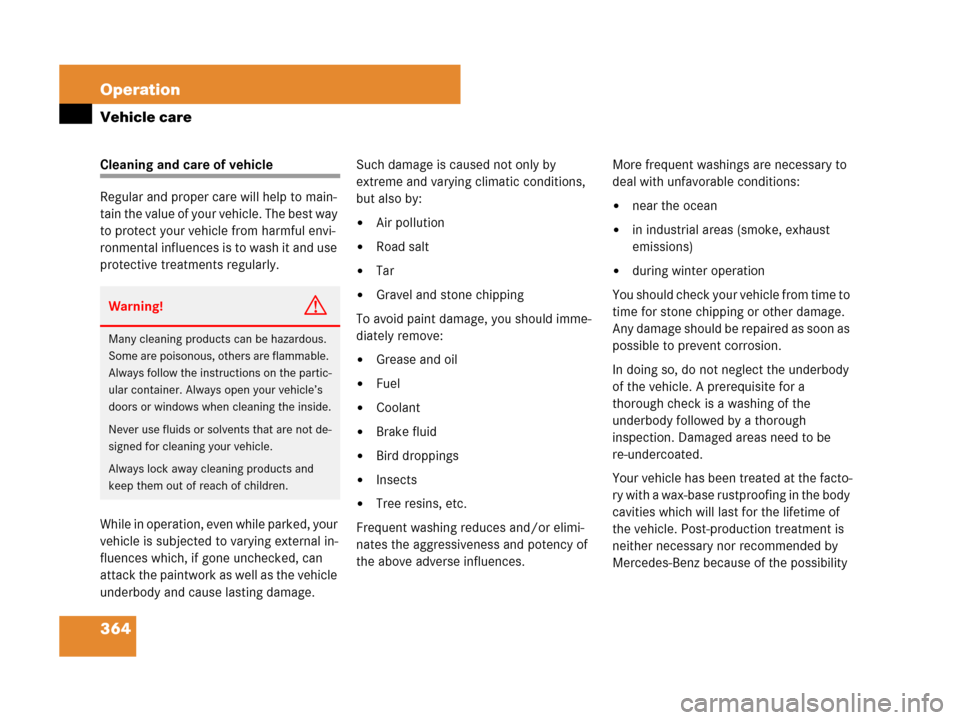
364 Operation
Vehicle care
Cleaning and care of vehicle
Regular and proper care will help to main-
tain the value of your vehicle. The best way
to protect your vehicle from harmful envi-
ronmental influences is to wash it and use
protective treatments regularly.
While in operation, even while parked, your
vehicle is subjected to varying external in-
fluences which, if gone unchecked, can
attack the paintwork as well as the vehicle
underbody and cause lasting damage.Such damage is caused not only by
extreme and varying climatic conditions,
but also by:
�Air pollution
�Road salt
�Tar
�Gravel and stone chipping
To avoid paint damage, you should imme-
diately remove:
�Grease and oil
�Fuel
�Coolant
�Brake fluid
�Bird droppings
�Insects
�Tree resins, etc.
Frequent washing reduces and/or elimi-
nates the aggressiveness and potency of
the above adverse influences.More frequent washings are necessary to
deal with unfavorable conditions:
�near the ocean
�in industrial areas (smoke, exhaust
emissions)
�during winter operation
You should check your vehicle from time to
time for stone chipping or other damage.
Any damage should be repaired as soon as
possible to prevent corrosion.
In doing so, do not neglect the underbody
of the vehicle. A prerequisite for a
thorough check is a washing of the
underbody followed by a thorough
inspection. Damaged areas need to be
re-undercoated.
Your vehicle has been treated at the facto-
ry with a wax-base rustproofing in the body
cavities which will last for the lifetime of
the vehicle. Post-production treatment is
neither necessary nor recommended by
Mercedes-Benz because of the possibility
Warning!G
Many cleaning products can be hazardous.
Some are poisonous, others are flammable.
Always follow the instructions on the partic-
ular container. Always open your vehicle’s
doors or windows when cleaning the inside.
Never use fluids or solvents that are not de-
signed for cleaning your vehicle.
Always lock away cleaning products and
keep them out of reach of children.
Page 388 of 509
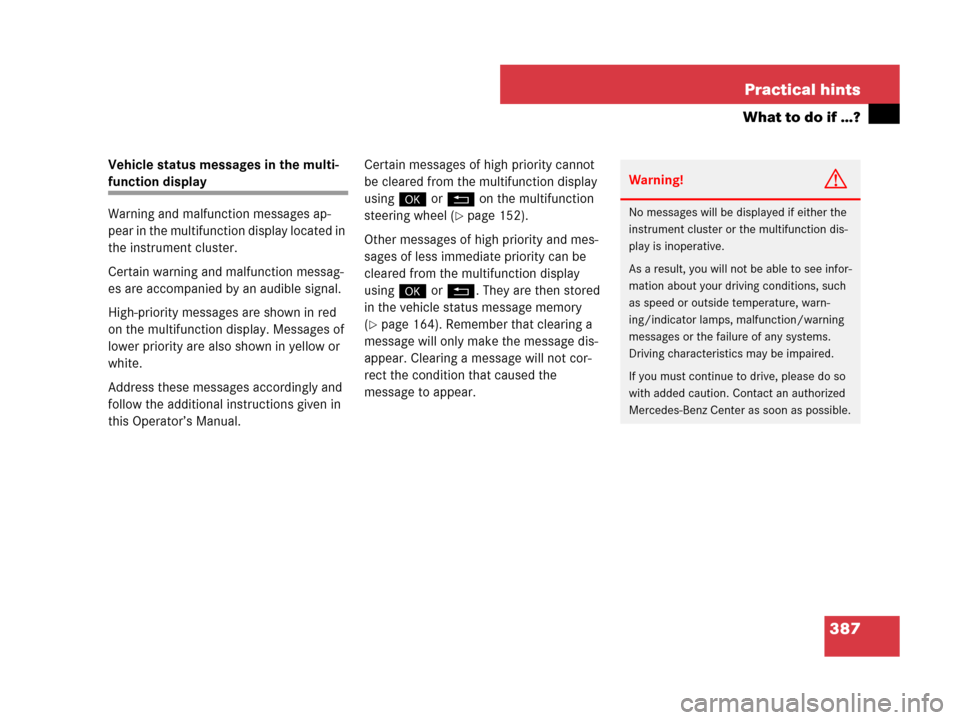
387 Practical hints
What to do if …?
Vehicle status messages in the multi-
function display
Warning and malfunction messages ap-
pear in the multifunction display located in
the instrument cluster.
Certain warning and malfunction messag-
es are accompanied by an audible signal.
High-priority messages are shown in red
on the multifunction display. Messages of
lower priority are also shown in yellow or
white.
Address these messages accordingly and
follow the additional instructions given in
this Operator’s Manual.Certain messages of high priority cannot
be cleared from the multifunction display
using# or L on the multifunction
steering wheel (
�page 152).
Other messages of high priority and mes-
sages of less immediate priority can be
cleared from the multifunction display
using# or L. They are then stored
in the vehicle status message memory
(
�page 164). Remember that clearing a
message will only make the message dis-
appear. Clearing a message will not cor-
rect the condition that caused the
message to appear.
Warning!G
No messages will be displayed if either the
instrument cluster or the multifunction dis-
play is inoperative.
As a result, you will not be able to see infor-
mation about your driving conditions, such
as speed or outside temperature, warn-
ing/indicator lamps, malfunction/warning
messages or the failure of any systems.
Driving characteristics may be impaired.
If you must continue to drive, please do so
with added caution. Contact an authorized
Mercedes-Benz Center as soon as possible.
Page 389 of 509
388 Practical hints
What to do if …?
On the pages that follow, you will find a
compilation of the most important warning
and malfunction messages that may ap-
pear in the malfunction display.
For your convenience the messages are di-
vided into two sections:
�Text messages (�page 389)
�Symbol messages (�page 397)
Warning!G
All categories of messages contain impor-
tant information which should be taken note
of and, where a malfunction is indicated, ad-
dressed as soon as possible at an autho-
rized Mercedes-Benz Center.
Failure to repair condition noted may cause
damage not covered by the Mercedes-Benz
Limited Warranty, or result in property dam-
age or personal injury.
iSwitching on the ignition causes all instru-
ment cluster lamps (except high beam headlamp
indicator lamp and turn signal indicator lamps
unless activated) as well as the multifunction dis-
play to come on. Make sure the lamps and multi-
function display are in working order before
starting your journey.
Page 395 of 509
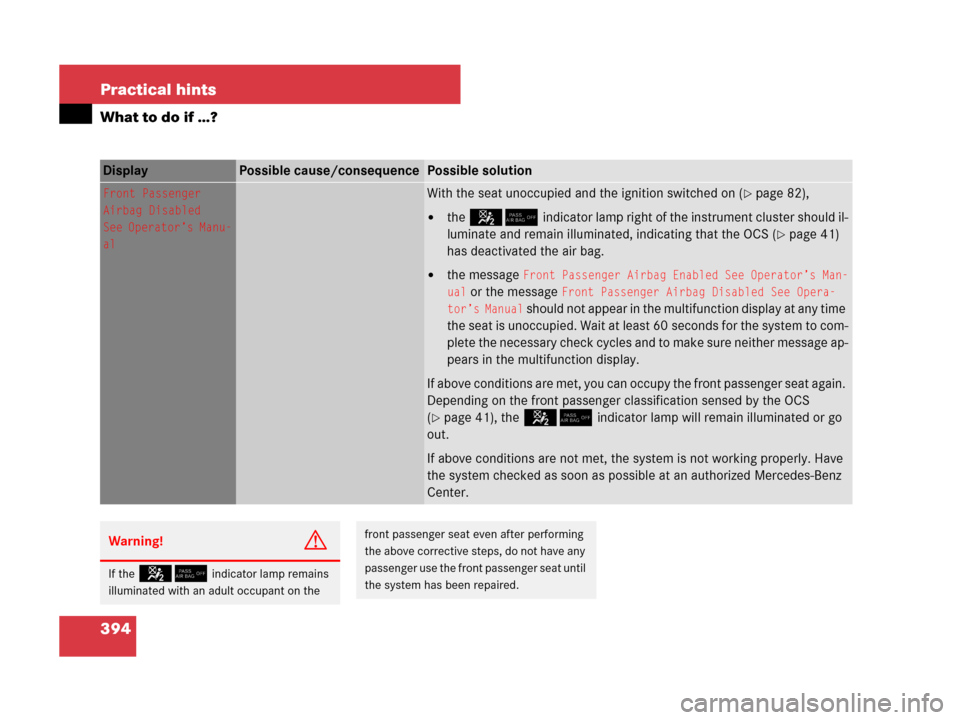
394 Practical hints
What to do if …?
Display Possible cause/consequencePossible solution
Front Passenger
Airbag Disabled
See Operator’s Manu-
alWith the seat unoccupied and the ignition switched on (�page 82),
�the 5/indicator lamp right of the instrument cluster should il-
luminate and remain illuminated, indicating that the OCS (
�page 41)
has deactivated the air bag.
�the message Front Passenger Airbag Enabled See Operator’s Man-
ual
or the message Front Passenger Airbag Disabled See Opera-
tor’s Manual
should not appear in the multifunction display at any time
the seat is unoccupied. Wait at least 60 seconds for the system to com-
plete the necessary check cycles and to make sure neither message ap-
pears in the multifunction display.
If above conditions are met, you can occupy the front passenger seat again.
Depending on the front passenger classification sensed by the OCS
(
�page 41), the5/indicator lamp will remain illuminated or go
out.
If above conditions are not met, the system is not working properly. Have
the system checked as soon as possible at an authorized Mercedes-Benz
Center.
Warning!G
If the 5/indicator lamp remains
illuminated with an adult occupant on the
front passenger seat even after performing
the above corrective steps, do not have any
passenger use the front passenger seat until
the system has been repaired.
Page 397 of 509

396 Practical hints
What to do if …?
Display Possible cause/consequencePossible solution
Front Passenger
Airbag Enabled
See Operator’s Manu-
alWith the seat unoccupied and the ignition switched on (�page 82),
�the 5/indicator lamp right of the instrument cluster should il-
luminate and remain illuminated, indicating that the OCS (
�page 41)
has deactivated the air bag.
�the message Front Passenger Airbag Enabled See Operator’s Man-
ual
or the message Front Passenger Airbag Disabled See Opera-
tor’s Manual
should not appear in the multifunction display at any time
the seat is unoccupied. Wait at least 60 seconds for the system to com-
plete the necessary check cycles and to make sure neither message ap-
pears in the multifunction display.
If above conditions are met, you can occupy the front passenger seat again.
Depending on the front passenger classification sensed by the OCS
(
�page 41), the 5/indicator lamp will remain illuminated or go
out.
If above conditions are not met, the system is not working properly. Have
the system checked as soon as possible at an authorized Mercedes-Benz
Center.
Warning!G
If the 5/indicator lamp remains
illuminated with an adult occupant on the
front passenger seat even after performing
the above corrective steps, do not have any
passenger use the front passenger seat until
the system has been repaired.
Page 465 of 509
464 Technical data
Layout of poly-V-belt drive
C 300/C 350
1Idler pulley
2Idler pulley
3Automatic belt tensioner
4Power steering pump
5Air conditioning compressor
6Crankshaft
7Coolant pump
8Generator (alternator)
Page 479 of 509
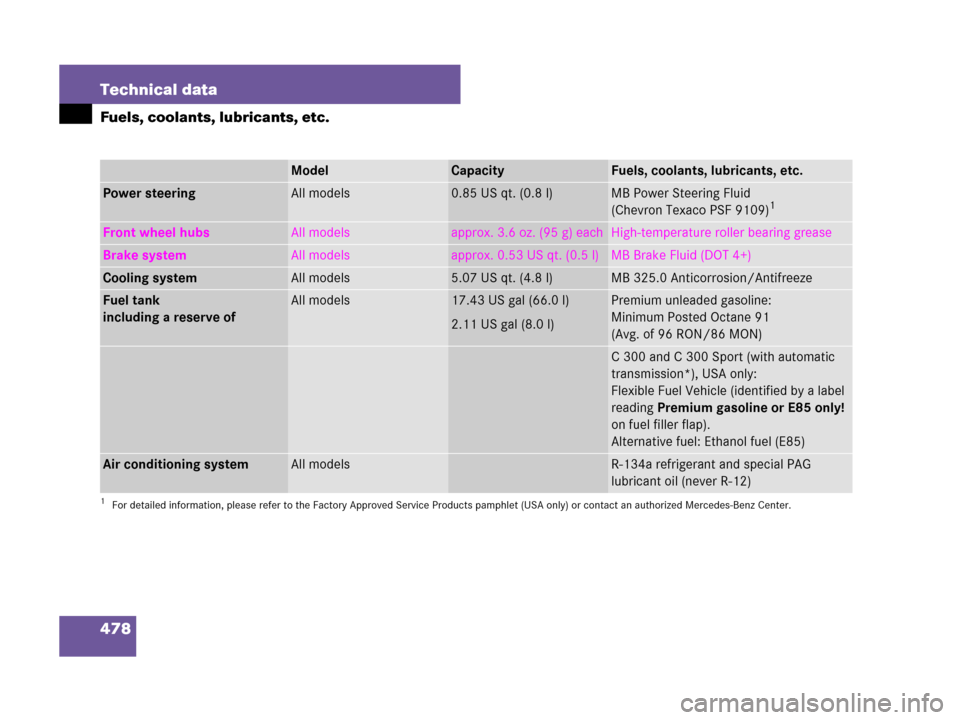
478 Technical data
Fuels, coolants, lubricants, etc.
ModelCapacityFuels, coolants, lubricants, etc.
Power steeringAll models0.85 US qt. (0.8 l)MB Power Steering Fluid
(Chevron Texaco PSF 9109)1
1For detailed information, please refer to the Factory Approved Service Products pamphlet (USA only) or contact an authorized Mercedes-Benz Center.
Front wheel hubsAll modelsapprox. 3.6 oz. (95 g) eachHigh-temperature roller bearing grease
Brake systemAll modelsapprox. 0.53 US qt. (0.5 l)MB Brake Fluid (DOT 4+)
Cooling systemAll models5.07 US qt. (4.8 l)MB 325.0 Anticorrosion/Antifreeze
Fuel tank
including a reserve ofAll models17.43 US gal (66.0 l)
2.11 US gal (8.0 l)Premium unleaded gasoline:
Minimum Posted Octane 91
(Avg. of 96 RON/86 MON)
C 300 and C 300 Sport (with automatic
transmission*), USA only:
Flexible Fuel Vehicle (identified by a label
reading Premium gasoline or E85 only!
on fuel filler flap).
Alternative fuel: Ethanol fuel (E85)
Air conditioning systemAll modelsR-134a refrigerant and special PAG
lubricant oil (never R-12)
Page 481 of 509
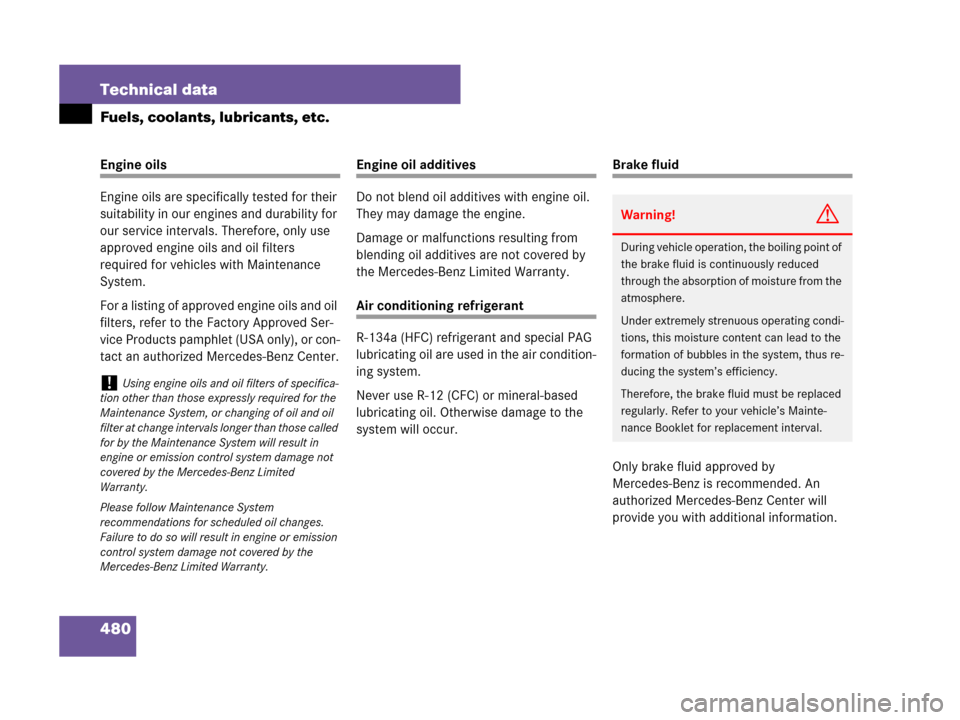
480 Technical data
Fuels, coolants, lubricants, etc.
Engine oils
Engine oils are specifically tested for their
suitability in our engines and durability for
our service intervals. Therefore, only use
approved engine oils and oil filters
required for vehicles with Maintenance
System.
For a listing of approved engine oils and oil
filters, refer to the Factory Approved Ser-
vice Products pamphlet (USA only), or con-
tact an authorized Mercedes-Benz Center.Engine oil additives
Do not blend oil additives with engine oil.
They may damage the engine.
Damage or malfunctions resulting from
blending oil additives are not covered by
the Mercedes-Benz Limited Warranty.
Air conditioning refrigerant
R-134a (HFC) refrigerant and special PAG
lubricating oil are used in the air condition-
ing system.
Never use R-12 (CFC) or mineral-based
lubricating oil. Otherwise damage to the
system will occur.
Brake fluid
Only brake fluid approved by
Mercedes-Benz is recommended. An
authorized Mercedes-Benz Center will
provide you with additional information.
!Using engine oils and oil filters of specifica-
tion other than those expressly required for the
Maintenance System, or changing of oil and oil
filter at change intervals longer than those called
for by the Maintenance System will result in
engine or emission control system damage not
covered by the Mercedes-Benz Limited
Warranty.
Please follow Maintenance System
recommendations for scheduled oil changes.
Failure to do so will result in engine or emission
control system damage not covered by the
Mercedes-Benz Limited Warranty.
Warning!G
During vehicle operation, the boiling point of
the brake fluid is continuously reduced
through the absorption of moisture from the
atmosphere.
Under extremely strenuous operating condi-
tions, this moisture content can lead to the
formation of bubbles in the system, thus re-
ducing the system’s efficiency.
Therefore, the brake fluid must be replaced
regularly. Refer to your vehicle’s Mainte-
nance Booklet for replacement interval.